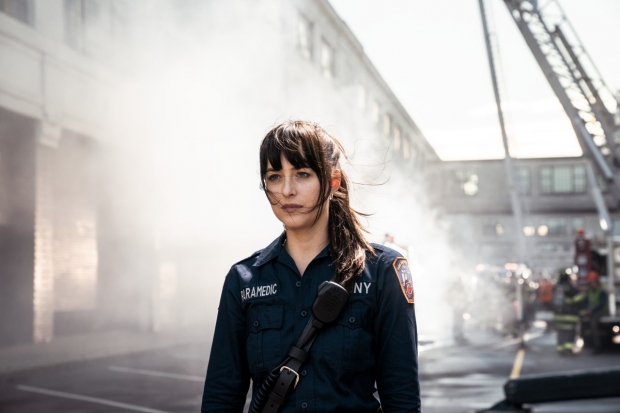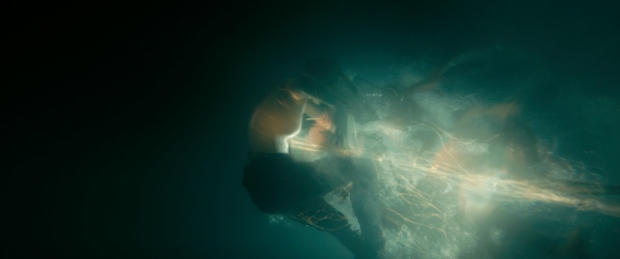SFX Supervisor Jeremy Hays and VFX Producer Whitney Richman discuss the challenges of conceptualizing and creating scenes involving astral projection, underwater characters that aren’t actually underwater, and the lead character, Cassandra Webb, falling off a bridge during a motor vehicle rescue, on S.J. Clarkson and Sony Pictures’ suspense thriller.
Getting practical and visual effects to seamlessly work together along with stunts is critical for making an entertaining and believable action-oriented movie, even when there are superpowers involved. On Madame Web, Sony Pictures’ suspense thriller origin story of a New York City paramedic, Cassandra Webb, imbued with clairvoyance and the ability to manipulate time, filmmaker S.J. Clarkson, VFX Producer Whitney Richman and SFX Supervisor Jeremy Hays worked together closely to bring a grounded quality to the film.
The path Cassandra (Dakota Johnson) took to discover her psychic powers began with a motor vehicle rescue where the paramedic fell off a bridge. “Initially, it was scheduled on the first day of shooting, but there was a rain or scheduling delay, so it ended up being a week later,” explains Hays. “On one hand it’s nice to start the tone right off the bat with something like that so you can get ready for the pace of what’s going to happen. But it is nerve-racking. Also, when they got everything set for the bridge that had been picked, it was only a couple of weeks before we were actually filming it. There was coordinating with the city, making sure that we could take the existing guardrails off and install ours in. It was on a weekend, so we had to come at 6 pm when they thought the traffic had died down enough, take the railing off, install our railing with the car, have a guard watch it over night, came in the next morning, shoot out the whole scene and then take it out later that night. It was fun to watch the reactions of people as they drove by because the bridge wasn’t completely closed down while we were installing it. While we’re testing the car, it was sometimes at an angle that literally looked like it’s about to fall off the bridge. Bystanders would be coming by going, ‘Woah!’ Stop and slow down. That helped to ground my relationship with [Visual Effects Supervisor] Mike Brazelton and S.J. We started to get an idea of what our relationships were going to be within the fast-paced schedule, what was absolutely needed as a foundation for whatever the effect was going to be, and where visual effects would takeover from there. It was mostly actor and car interaction. The actors get in and we would test. It felt natural to them tipping over the edge [of the bridge] and how the guardrail grabbed onto and closed the [ambulance] door as it came over the edge. That was a fun start to the show.”
When breaking down the script for the VFX work bidding, it was important to anticipate that the shot count would increase as the production progressed. All told, 1,400 shots were produced by Digital Domain, beloFX, One of Us, Outpost VFX and Territory Studio. “I have yet to be on a show where the shots decreased,” notes Richman. “Hopefully, one day! I came in right after they got back from production so I actually wasn’t on location. These breakdowns were done prior to me joining the show. But the hardest visual effects were the most abstract ones, like the underwater sequences. Across the board there are about three of them. And astral projection. S.J. was brilliant at developing these creative paths while working on the edit so that changed significantly from where we started to ended up. Those sequences were the hardest because Cassie is supposed to be underwater but is really not underwater. How do we tell the story that S.J. wants in visual effects? It not really being underwater but showing the same simulations. The cutting process was difficult. There was always the backstory. But things always change. I have yet to be on a show where the original breakdown is close to what you end up with.”
In one major sequence, an ambulance was flipped on a street in Boston, where most of the principal photography took place. “We had to take the full-sized ambulance and determine the distance from the height it was going to launch to and where it was going to land before shooting that scene at the intersection,” explains Hays. “We put together a virtual set at a different location in a hanger, did the testing to determine the distance that the thing would crash, then took that information to the intersection, and basically did a small jump ramp so that the ambulance would land in the spot where we predicted it would when we actually shot it later. Then we prepped the vehicle that we had exploded and flipped in the intersection.”
Because the historic downtown financial district has a considerable number of glass buildings, the city is protective about damage to the environment. “We were threading a needle,” Hays shares. “There is a streetlight you cannot hit that the car is next to, plus a slight pitch to the road, so naturally, if you were going launch the thing straight up, it would want to go towards the light. We had to cheat it a little bit with the cannon that lifts the car in the air towards the passenger’s side by offsetting it towards the intersection. I’ve done a fair amount of them over the years but you always feel like you’re winging it on the day based on past experience because we didn’t have a car to test before that. It had a big nitrogen cannon that pushes the car up. I probably could have got another 200 pounds of pressure on that but it was fun, the city was great about it, and we didn’t destroy anything.”
Cassandra’s ability to astral project out of her own body was the hardest superpower to conceptualize. “With Doctor Strange, they shot it in a specific way that is brilliant,” states Richman. “But Doctor Strange and Cassie are two completely different people. How do we make it Cassie’s astral projection? That was hands down the hardest. The girls were so much fun because there was always a plan for them. Julia Cornwall [Sydney Sweeney] has electric webs. We had to figure out what color. Blue is cool. Orange is hot. Is it burning or cooling? If you mix yellow in there sometimes it looks like urine! How do you show a stream of electricity that isn’t so typical? You want to believe it. We struggled with those webs and then Mike Brazelton made them look incredible with our vendor Digital Domain, from the idea of what they were, to the arcs and how they branch off. The color is perfect because it’s not like anything out there.”
When it came to Cassandra seeing what happens in the future, most of the effect was captured in-camera. “The flashforwards were all S.J. Clarkson, who used her diopter to get in and out of the mind’s eye as she called it. Visual effects did very few CG diopters.”
Conveying inertia was critical in combatting the weightlessness that occurs when characters defy gravity. “The audience has become a lot more aware of what feels psychologically real,” states Hays. “You’re always taking into consideration how energy transfers from one object to another. If there is no actual person hitting the thing it has to move as if it had that energy. It’s a big part of the job because it will make or break if you’re good at the special effects. Working in close relationship with visual effects, sometimes it helps them the most if we can at least get part of the reaction of what the superhero is doing in-camera, so that they have something to build off and can put in a lot of the details.” One last-minute contribution was a water tank for an underwater fight. “Halfway through production the producers went, ‘Do you remember that water tank thing? We should probably do that.’ Mauro Fiore [cinematographer] wanted these glass viewing windows to be able to shoot a bunch of light in there, which made the engineering a whole lot more complicated. Through the creative process the grips went in and put blacks over those windows to block all the light. We ended up shooting inside of a dark tank with the stunt people and the actress. It was three weeks of all day and night trying to get the thing finished.”
The abstract nature of the Web of Life complicated the visual effects process. “Showing underwater in the beginning, when Cassie sees visions of the future, that environment was tough,” admits Richman. “It looks like its underwater because the car is going down. But it’s not underwater. How does the hair move and the stuff in the background? I was afraid that we were going to go too Stranger Things with the Underworld but S.J. wanted that web connected to Cassie and all things. It is called the Web of Life and that Web of Life connects us all. It connects her to everything she needs to know and the portals and background webs. Thank God for the concepts of Luis Guggenberger because they planted the seeds for the look, not only for under the water but also down on the roof. How she astral projects. When she is astral projected, those portals have to marry each other because that’s the power. You don’t want it to look like portals and worlds of Doctor Strange. You also must give it some depth so it’s not looking like a flat object. It’s a 3D world and 3D asset, but webs are so hard because of how thin and delicate they are. You think it’s silk, how it moves and vibrates, and how water lands on it. But it’s beyond all of that. Webs are white in our eyes. But they are not white. How do you see that in this world that isn’t a real one? Mike definitely had his work cut out for him and so did S.J. It was definitely a process, but the reward was, ‘This is awesome. We did something unlike anything.’”
























